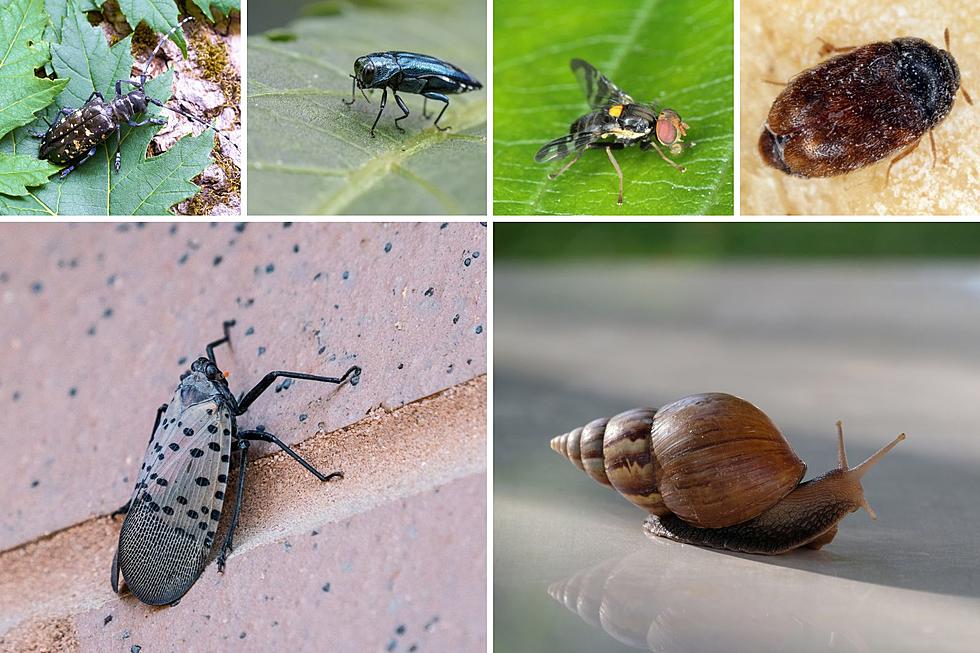
If You See Any of These 8 Pests in Michigan, Immediately Squish Them
We have a lot of bugs in Michigan. Tons of mosquitoes during the summertime and annoying pests that swarm us during the warmer months. Which ones should you squish immediately because they are an invasive species?
As annoying as these pests are to us as humans, they have a massive effect on our ecosystem. What is an invasive species? This is the definition from the State of Michigan:
An invasive species is one that is not native and whose introduction causes harm, or is likely to cause harm to Michigan's economy, environment, or human health.
Many non-native species in Michigan, including fruits, vegetables, field crops, livestock and domestic animals, are important to our economy and lifestyle. Most non-native species are not harmful and may provide economic benefits. Invasive species cause harm when they out-compete native species by reproducing and spreading rapidly in areas where they have no natural predators and change the balance of the ecosystems we rely on.
As you can see in the pictures below, these are the species we've grown to strongly dislike. I'm not the guy that kills bugs every time I see them. I will however be on the lookout for the following pests to do my part to protect our state from pests.
8 Pests You Should Squish Immediately in Michigan
Giant African Snail
The USDA says:
GAS is one of the most damaging snails in the world because it consumes at least 500 types of plants and can cause structural damage to plaster and stucco structures. This snail can also carry a parasitic nematode that can lead to meningitis in humans. One of the most damaging snails in the world. GAS reproduces quickly, producing about 1,200 eggs in a single year.
Asian Longhorn Beetle
These beetles aren't any good. Michigan says:
The Asian longhorned beetle can attack and kill many tree species including poplar, willow, sycamore, and horse chestnut, but its favorite host are maple trees. The larvae feed in tunnels in the wood of the tree branches and trunks, eventually killing the tree.
Rhagoletis Cerasi
The USDA explains why these pests are the worst:
Fruit flies in the family Tephritidae are among the most destructive, feared and well-publicized pests of fruits and vegetables around the world. The genera Anastrepha, Bactrocera, and Ceratitis pose the greatest risk to U.S. agriculture. Tephritid fruit flies spend their larval stages feeding and growing in over 400 host plants. Introduction of these pest species into the United States causes economic losses from destruction and spoiling of host commodities by larvae, costs associated with implementing control measures, and loss of market share due to restrictions on shipment of host commodities. The extensive damage and wide host range of tephritid fruit flies become obstacles to agricultural diversification and trade when pest fruit fly species become established in these areas.
Khapra Beetle
I don't know much about these pests however the USDA does:
The Khapra Beetle(Trogoderma granarium) is one of the world’s most destructive pests of stored grain products and seeds. Its feeding damage often spoils 30 percent of the product; up to 70 percent damage has been reported. Previous U.S. detections of this tiny beetle have required massive, long-term and costly control and eradication efforts. Established infestations are difficult to control because the beetle can survive without food for long periods, requires little moisture, hides in tiny cracks and crevices, and is relatively resistant to many insecticides and fumigants.
Spotted Lanternfly
This pest is a real nuisance. They're also known locally as stink bugs. The USDA doesn't hold back:
The spotted lanternfly (Lycorma delicatula) is an invasive plant hopper from China that was first detected in North America in 2014. Juvenile spotted lanternflies, known as nymphs, and adults prefer to feed on the invasive tree of heaven (Ailanthus altissima) but also feed on a wide range of crops and plants, including grapes, apples, hops, walnuts and hardwood trees.
Emerald Ash Borer Beetle
These pests don't just bother us in Michigan. USDA shares:
The emerald ash borer (Agrilus planipennis) is a destructive wood-boring pest of ash trees (Fraxinus spp.). Native to China, Mongolia, North Korea, South Korea, Japan, Taiwan, and the Russian Far East, the emerald ash borer beetle (EAB) was unknown in North America until its discovery in southeast Michigan in 2002. Today, EAB infestations have been detected in 36 states and the District of Columbia; Alabama, Arkansas, Colorado, Connecticut, Delaware, Georgia, Illinois, Indiana, Iowa, Kansas, Kentucky, Louisiana, Maine, Maryland, Massachusetts, Michigan, Minnesota, Missouri, Nebraska, New Hampshire, New Jersey, New York, North Carolina, Ohio, Oklahoma, Oregon, Pennsylvania, Rhode Island, South Carolina, South Dakota, Tennessee, Texas, Vermont, Virginia, West Virginia, and Wisconsin. APHIS works with State cooperators to detect, control and prevent the human-assisted spread of the pest in order to safeguard America’s ash trees.
European Grape Moth
Although this video is set in California, we have a lot of wineries in Michigan and these pests affect the wineries in the Mitten. The USDA shares:
The European Grapevine Moth (lobesia botrana or EGVM) is a significant agricultural pest throughout much of the world. It was first detected in the U.S. in California in September 2009 and fully eradicated in August 2016. The European Grapevine Moth is such a big threat because it can feed on the flower or fruit of host plants, most often grapes. If the moth attacks mature grape clusters, the berries can become further damaged through a potentially deadly infection of a fungus called botrytis, also known as bunch rot.
Flighted Spongy Moth Complex
Let's learn more from the USDA:
The flighted spongy moth complex (including Lymantria dispar asiatica, L. dispar japonica, L. albescens, L. umbrosa, and L.post-alba, also formerly known as the Asian gypsy moth) is a group of exotic pests of Asian origin not known to occur in the United States. If they would become established here, they could cause serious, widespread damage to our country’s landscape and natural resources. Flighted spongy moths are similar to the spongy moth known to occur in Europe and under quarantine in the northeastern United States, but have a much broader host range. Each female moth can lay hundreds of eggs that, in turn, yield hundreds of voracious caterpillars that may feed on more than 600 tree and shrub species. Large flighted spongy moth infestations can completely defoliate trees. This defoliation can severely weaken trees and shrubs, making them more susceptible to disease. Repeated defoliation can lead to the death of large sections of forests, orchards and landscaping. Flighted spongy moth complex females—unlike the spongy moths that occur in Europe—are active fliers. Their ability to fly long distances makes it probable that this moth complex could quickly spread throughout the United States

